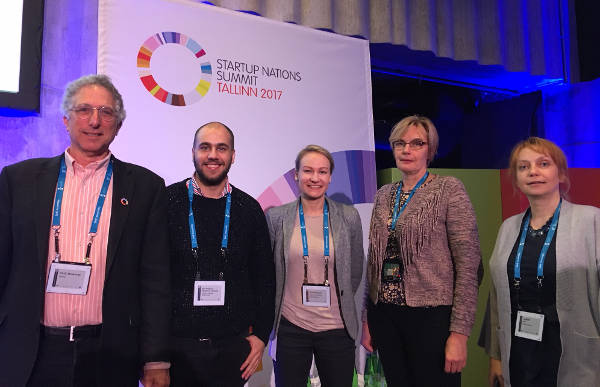Government procurement for innovative solutions sucks. Here’s one way to fix it.
I was privileged to participate in the Startup Nations Summit Policy Hack earlier this year in Tallinn, Estonia. This one day policy hackathon brought together representatives from all over the world, working on different problems.
On the day before the Policy Hack, the conference organisers invited me to present a session on the Lean Policy Canvas, which was very well received. On the back of my presentation, the Lean Policy Canvas is being taken global by the conference attendees, and being translated into other languages. And I was really pleased that at the hackathon itself, most of the teams used the Canvas.
I was part of a team led by the Estonian Ministry of Economic Affairs and Communication working on improving government procurement of innovative solutions.

Our team comprised (L-R): Dave Moskovitz (NZ), Rui Cardoso (Scotland), Sigrid Rajalo (Estonia), Kylli Raidma (Estonia), Maarika Tork (Estonia). Not in photo: Kewal Prasad Bhandari (Nepal).
The specific problem the Estonian Ministry of Finance set for us was:
- A compliance-heavy procurement process stifles innovation
- A lack of communication between procurers and vendors results in inferior product quality
- The process raises high barriers for small companies and startups to participate
We quickly realised that that at its heart, the real problem is:
Government tends to procure highly specified products, rather than solutions to problems.
The natural tendency of governments to want to manage risk leads them to try to specify and control everything, but that just doesn’t work when you’re working in an environment with a lot of unknowns – in other words, innovating.
This problem is not unique to Estonia by any means – I’ve seen it up close and personal in New Zealand, and it was confirmed by the other members of our team from Nepal and Scotland.
We used the following visual metaphor to describe the outcomes.
This is what the procurers ordered:

This is what citizens actually wanted:

This is what was delivered:

Our solution to this problem involves breaking the procurement process into four stages. In addition, we believe government procurers should be directed to spend a small percentage of their purchasing budgets on research and development.
Stage 1: Problem Definition
The procurer describes the problem they want solved (not what the solution must look like), and distributes a very short Request for Expressions of Interest (EOI) to the marketplace. Any business – small or large, young or established – can submit an EOI. A maximum length of 2 pages is strictly enforced. Respondents are expected to outline their understanding of the problem, a very high level description of their solution, and their approach.
The [three] best responses are selected for advancement to the next stage.
Stage 2: Exploration and prototype
Each of the [three] vendors enters a [three week] exploration phase in which there is frequent and deep collaboration with the procurer. The vendors are paid [$10,000] each for their work in this phase. The output of this phase is three prototypes which could range from sketches to wireframes to skeletal working systems. The more important outcome is that the procurer learns what it’s like to work with each of the vendors, and can scrutinise the artifacts arising from the work.
The best vendor is selected for advancement to the next stage.
Stage 3: MVP
The successful vendor spends [three months] building a minimum viable product that implements the solution, and is paid [$70,000] for this work.
Stage 4: Full development
This is where the normal government procurement procedures would kick in. The big difference is that by this stage, the procurer has an excellent understanding of the problem and possible solutions, and has relationships with several vendors who have a more than cursory understanding of the issues.
Note that the time frames and dollar amounts above are in brackets because these will vary from project to project, but we felt that these numbers would be indicative of the magnitude. In each phase, payments would be distributed with half of the total payment at the start of the phase, and the rest on successful completion.
This regime has many benefits for both procurer and vendor. The key is the focus on the problem rather than a specific solution, which enables much greater innovation than would is possible when vendors are asked to compete on price for a highly specified solution. For the procurer, the phased approach means that the total up-front risk is limited to [$100,000]. Failure, if it occurs, is likely to happen early on in the process.
Benefits for the procurer:
- Total up-front risk is limited to [$100,000]. Costs and risks are known up front.
- Failure, if it occurs, is fast and cheap
- Focuses on the problem rather than a specific solution
- Opens the process up to a much more diverse set of players
- Enables greater innovation
Benefits for the vendor:
- Greater license to innovate
- Lowers barriers to access government work
- Significantly lower risk to respond
- Eliminates most of the unpaid work aspect of responding to government tenders
- Builds trust relationships with procurers
These benefits to procurers and vendors also help out the local ecosystem: sensibly managing innovation risk broadens the capability of smaller local companies, and enables them to develop greater capability and design solutions that could suit corporates and governments both in their local jurisdictions as well as further afield. And with a broader, more capable set of local companies to work with, government can build better solutions more quickly and flexibly. Everyone wins!
Our solution isn’t rocket science, it just requires the political will to make it happen. What are we waiting for?
Sounds grand … let’s make Cambio fly!!
Together with Ed and Nigel via “@CambioNZ” at the first R9 Accelerator (2015) we tackled exactly this problem (similar thinking as yourself): https://www.youtube.com/watch?v=MBC4ALLnXOo
It was, too ‘innovative’ – has it’s time finally come?
Check out our write-up: https://goo.gl/UaCqLD